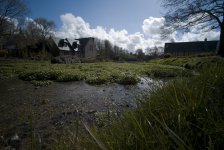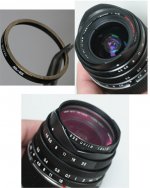Hi Dante. Always enjoyed your site/articles. Hope I can help here. I've had the 15 since it first came out, so I've used it on film for quite a while. I bought the 12 when I found a good deal on one used, basically intending to save it for a digital M which I figured would have a crop factor, to assume the duties the 15 had on a film body. Naturally I did shoot it on film, but only a little, as I really find it way too wide for any use I have. Initially my foray into M digital was an Epson R-D1, but now use both lenses on the M8.
The 15 was always a great lens, but it's even better on the M8 than on film, although it was worse (awful vignetting) on the R-D1. The M8 crops the part of the image where most of the 15's distortion and aberrations are. (It does that with all lenses, leaving the "sweet spot", which is one reason I prefer cropped sensors to full-frame). As I said, vignetting on the M8 is very well-controlled, which was a pleasant surprise after the R-D1.
The 12 is probably a better-corrected lens than the 15. At least, I found it so both on film and digital. Oddly it vignetted much less than the 15 on the R-D1. On the M8 they are both about the same. Again, the M8 crops the worst part of the image circle and leaves the best. Like the 15, if you have the 12 tilted off axis at all, you're bound to get distortion, but with everything square to the world, my experience is that the 12 is probably the more rectilinear of the two.
The biggest advantage to the 15 is the ergonomics. It's small, and it's easy to DIY filter threads to accept an IR filter that won't vignette even with film bodies. No need for expensive aftermarket filter holders. I'm still experimenting with the 12. I have Cosina's 77mm filter adaptor for it, and a 77mm IR filter, but I'm planning to experiment with epoxying an empty filter mount inside the little lens shade, which would take a smaller filter. Similar to what I did with the 15.
One other disadvantage with the 12 is that so far I've been needing to use PanoTools to correct the cyan corners resulting from the IR filter. It's not a big deal but it is an extra step. I've been meaning to try it using the WATE-coded adaptor off my 15 to see how the 16mm setting looks. It would be great if it worked.









